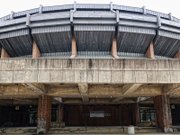The city rundown:
$1.2B needed to maintain infrastructure
5/13/2016, 6:38 a.m.

The City of Richmond needs to borrow $1.2 billion during the next 10 years to maintain its streets, provide sidewalks, ensure dozens of bridges remain usable and keep its 84 buildings in good shape, according a mayoral task force examining the future borrowing needs of the city government.
That doesn’t count $650 million needed in the next 10 years to provide quality school buildings — either new or renovated, according to Richmond Public Schools, which is participating in the task force.
The only problem: The city doesn’t have the capacity to borrow that kind of money.
According to a report David Rose, the city’s financial adviser, provided to Richmond City Council, Richmond would be able to borrow a total of $329 million in the 10-year period between 2018 and 2027 under current policies.
In fact, the only sector of city government that will have the borrowing capacity to meet virtually all of its needs is the Department of Public Utilities, which has a dedicated stream of revenue from customer payments for water, sewer service and natural gas to support its debt.
The tight squeeze on borrowing is creating one of the biggest challenges that will face the next mayor and City Council following the November elections — how to modernize worn out school buildings while keeping the city’s infrastructure from wearing out.
For Mr. Rose, it’s a familiar problem.
“This is typical for local governments,” said the senior vice president for Davenport & Co., who is a recognized expert in public finance.
Richmond is like every big city, he said, with “more needs than borrowing capacity. Even at the best of times, we don’t have enough capacity to do all the things that need to be done.”
But this is not the best of times. Despite a surge in population and private construction, revenue coming into the city is increasing at less than 2 percent a year.
To balance the budget for the 2017 fiscal year that begins July 1, City Council had to go along with the mayor’s plan to slash departmental budgets by 12 percent and to increase the cost of metered parking and trash collection.
And even though the council came up with an additional $5.5 million for schools, most of that money came from one-time increases in revenue — not an assured stream of new income.
When it comes to maintaining infrastructure, the city has hurt itself by refusing to make that a priority.
Given a choice of investing $175 million in four new schools or spending the money to upgrade and renovate at least 15 buildings, the mayor and council chose to build a new high school, middle school and two elementary schools and leave the problem of fixing the other buildings to another time.
John Buturla, Richmond’s deputy chief administrative officer for operations, compiled the needs on the city side and the shortfall is obvious.
His numbers suggest the city would need to borrow $116 million a year for each of the next 10 years just to meet infrastructure needs.
However, the capital budget the council is poised to pass Friday, May 13, provides, at most, $68 million for city infrastructure, with that amount expected to shrink each year through fiscal year 2021. In fiscal year 2021, the city would be able to borrow just $11.1 million for infrastructure needs.
Mr. Buturla projects a need to borrow $10 million a year — or $50 million over five years — to maintain the city’s 84 buildings. However, the capital budget shows that a total of just $4.3 million is expected to be available to maintain city buildings ranging from City Hall to the courthouses and fire stations — a $46 million shortfall.
Schools are also a great example of the shortfall. This year, the School Board requested the city provide $41 million in fiscal year 2017 to meet maintenance requirements for its current buildings and then provide a total of $53.5 million during the next four years. That’s a total of $94.5 million for the 2017-2021 period.
However, the council is budgeting only $14.6 million for school maintenance during that five-year period, $80 million short. In fiscal year 2017, the council has earmarked just $9 million for school maintenance, $4 million more than the mayor proposed, but still $32 million short of the School Board’s request.
Next week, when the task force meets again, Mr. Rose is expected to offer some ideas for boosting the city’s ability to borrow and address more of its needs.
One idea, as he told the council in his report, might be for the city to change its policy to boost its borrowing capacity.
Mr. Rose’s report suggests the policy change could boost the borrowing capacity to $580 million over the 10 years — but it is unclear whether the city would have the revenue to repay the increased debt.
This year, the city expects to spend about $70 million to repay debt. If the council increased borrowing levels to address maintenance, more money would have to go to debt service, leaving even less for its own and the school system’s operations.
Mr. Rose said that for the council to approve extra borrowing, the city would need to generate additional revenue. He said for every $100 million in new borrowing at current interest rates, the city would need to pay $7.5 million a year. “And that is not just for one year,” he said. “That would be each year for the next 20 years.”
“The city has to be realistic if it decides to use more revenue for debt service,” he said. He said there are plenty of examples of governments that ran into financial trouble by over borrowing, with Puerto Rico and Detroit being prominent examples.
Still, unless taxes are increased, or the city finds some other way to dramatically boost revenue, the money to overhaul schools and maintain city infrastructure is unlikely to be available.








